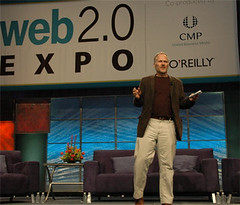Tim O’Reilly, Web 2.0 Guru, on harnessing Collective Intelligence
 Tim O’Reilly is among the most influential thought leaders in the Web 2.0 field. O’Reilly has been referred to as one of the gurus of the participation age. His firm coined the term “Web 2.0” and they host pivotal summits and expos in the Valley and around the globe.
Tim O’Reilly is among the most influential thought leaders in the Web 2.0 field. O’Reilly has been referred to as one of the gurus of the participation age. His firm coined the term “Web 2.0” and they host pivotal summits and expos in the Valley and around the globe.
When it comes to the crowd, O’Reilly uses the terms “collective intelligence” rather than “crowdsourcing.” What does that mean? O’Reilly has identified a couple of important concepts that are connected to the idea of harnessing collective intelligence.
First, is the idea of what he has called the open source paradigm shift. In today’s environment, there is a process of commoditization where the value is going out of many classes of software that people used to pay for. But there is still value; it is a question of where on the stack the value is located. This led O’Reilly to rethink the nature of the web and to come up with some new ideas around what is now referred to as “Web 2.0.” Moving up the stack includes using the internet as a platform, software as a service and harnessing collective intelligence.
By contrast, there is what O’Reilly calls moving down the stack, such as “Data is the Next Intel Inside” concept. This analysis is based on what Clayton Christensen calls “The Law of Conservation of Attractive Profits” (I discuss this in e-Preneur in the discussion of Christensen’s writings in Step #2 under “Classic Insights on Innovation”). The basic point is that every time you see something for free, then something else is becoming expensive. The impetus for this development was Linux and other types of open source software, which was a disruptive force that changed the game. Open source software leverages the power of network effects, enlightened self-interest, and the architecture of participation. But the trend didn’t stop there. O’Reilly noticed that many of the most successful websites were also harnessing user participation and the network effects that ensue.
Second, the internet is the platform. O’Reilly explains that once you realize that we’re in a new platform era, you have to ask yourself what makes for success on that platform. On the PC, it was all about building applications for individual user productivity. On the network, it’s about building applications that enable shared activity. But that’s not just explicit collaboration. It also includes implicit collaboration.
O’Reilly’s view is that to the extent that any Web 2.0 company uses network effects to their fullest potential they have harnessed collective intelligence. Google’s realization that links were a kind of user generated “voting” on the best site for a topic (i.e. Page Rank) and could be used to deliver better search results was arguably the real beginning of the Web 2.0 revolution. But each in their own way, Yahoo, eBay, Amazon, Craigslist and Wikipedia all are showing different ways to harness collective intelligence to add value. Amazon, for example, has doggedly and persistently pursued the notion of users adding value. They didn’t have a built-in architecture of participation, but they worked on it.
O’Reilly explains that, “the key is to work together; harnessing creative intelligence is the heart of Web 2.0.” O’Reilly notes that the key question for companies to get involved in Web 2.0 is to ask, “what can we do on a shared network?” The objective is to build networks that get better as more people use them; this is the basis for the next generation of internet companies.











